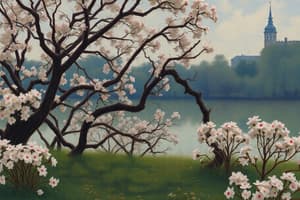Podcast
Questions and Answers
Imagery is the art of creating a mental image through the use of ______ language
Imagery is the art of creating a mental image through the use of ______ language
descriptive
Alliteration is the repetition of the same sound at the beginning of two or more words in a ______ or line
Alliteration is the repetition of the same sound at the beginning of two or more words in a ______ or line
sentence
Alliteration adds ______ to poetry and can create memorable, rhythmic patterns
Alliteration adds ______ to poetry and can create memorable, rhythmic patterns
musicality
In the line, 'The silly snake slithered so ______,' the alliteration on the 's' sound creates a playful, almost hypnotic effect
In the line, 'The silly snake slithered so ______,' the alliteration on the 's' sound creates a playful, almost hypnotic effect
Signup and view all the answers
Symbolism is the use of objects, characters, or events to represent abstract ______, emotions, or spiritual concepts
Symbolism is the use of objects, characters, or events to represent abstract ______, emotions, or spiritual concepts
Signup and view all the answers
Symbols can manifest in various ways, such as the red rose symbolizing love or the phoenix symbolizing ______ and renewal.
Symbols can manifest in various ways, such as the red rose symbolizing love or the phoenix symbolizing ______ and renewal.
Signup and view all the answers
Symbolism helps poets to convey complex ideas or feelings through simple and ______ images.
Symbolism helps poets to convey complex ideas or feelings through simple and ______ images.
Signup and view all the answers
Rhyme scheme, the pattern of end-rhymes within a poem, adds structure and ______ to poetry.
Rhyme scheme, the pattern of end-rhymes within a poem, adds structure and ______ to poetry.
Signup and view all the answers
Meter refers to the pattern of stressed and unstressed syllables in a line of poetry. It helps create a rhythmic and ______ quality to the poem.
Meter refers to the pattern of stressed and unstressed syllables in a line of poetry. It helps create a rhythmic and ______ quality to the poem.
Signup and view all the answers
Personification is the attribution of human qualities to non-human entities, such as animals, plants, or ______ objects.
Personification is the attribution of human qualities to non-human entities, such as animals, plants, or ______ objects.
Signup and view all the answers
Study Notes
Unraveling the Magic of Poetry Techniques: A Comprehensive Guide
Poetry, a timeless art form, has the power to evoke emotions, provoke thought, and broaden our perspectives. At its core, poetry relies on a specific set of techniques that enable poets to create vivid, captivating narratives. In this article, we'll delve into some of the most popular and influential poetry techniques, such as imagery, alliteration, symbolism, rhyme scheme, meter, personification, metaphor, simile, and alliteration.
1. Imagery
Imagery is the art of creating a mental image through the use of descriptive language. By carefully selecting words that conjure up specific visuals, auditory, tactile, or olfactory sensory experiences, poets can help readers visualize their subjects with ease. For example, in the line, "The sunflowers stretched towards the sky like anxious children," the reader can visualize sunflowers, their long stems, and the impression of eager children reaching upwards.
2. Alliteration
Alliteration is the repetition of the same sound at the beginning of two or more words in a sentence or line. It adds musicality to poetry and can create memorable, rhythmic patterns. For instance, in the line, "The silly snake slithered so silently," the alliteration on the "s" sound creates a playful, almost hypnotic effect.
3. Symbolism
Symbolism is the use of objects, characters, or events to represent abstract ideas, emotions, or spiritual concepts. Symbols can manifest in various ways, such as the red rose symbolizing love or the phoenix symbolizing rebirth and renewal. Symbolism helps poets to convey complex ideas or feelings through simple and relatable images.
4. Rhyme Scheme
Rhyme scheme, the pattern of end-rhymes within a poem, adds structure and meter to poetry. Poets can choose from a variety of rhyme schemes, such as ABAB, ABCC, ABAAB, and so on. For example, in the poem "The Ode to a Nightingale" by John Keats, the ABCC rhyme scheme contributes to the overall musicality and flow of the poem.
5. Meter
Meter refers to the pattern of stressed and unstressed syllables in a line of poetry. It helps create a rhythmic and musical quality to the poem. There are several types of meters, such as iambic, anapestic, and trochaic. For example, in the line, "The bard sings sweetly, soothing our sorrows," the iambic meter creates a rhythm that flows smoothly and effortlessly.
6. Personification
Personification is the attribution of human qualities to non-human entities, such as animals, plants, or inanimate objects. Personification is often used to create a more relatable and sympathetic image of the subject, making it easier for the reader to connect with the poem's themes. For instance, in the line, "The wind howled through the trees like a wolf's cry," the personification of the wind as a wolf helps the reader to visualize the powerful force of the wind.
7. Metaphor
Metaphor is a figure of speech that compares two different things, implying that they share similarities or qualities. Metaphors can be used to create striking images and to make complex ideas more accessible to the reader. For instance, in the line, "Her eyes were windows to her soul," the metaphor of her eyes as windows helps the reader to visualize the depth of her emotions.
8. Simile
Simile is a figure of speech that compares two different things using the words "like" or "as." Similes can be used to create vivid images and to emphasize the similarities between two things. For example, in the line, "Her laughter was like a summer breeze," the simile helps the reader to visualize the lightness and playfulness of her laughter.
9. Alliteration (Again!)
We've already mentioned alliteration as a technique, but it's so important that we'll reiterate (pun intended) its significance. Alliteration is a poetic device that adds musicality and rhythm to poetry. It can be used to create memorable lines and to create a sense of unity within the poem.
In conclusion, poetry techniques provide poets with the tools to create vivid, engaging, and memorable narratives. By mastering these techniques, poets can craft works that have the power to inspire, provoke, and shape the human experience. So, keep exploring, experimenting, and enjoying the art of poetry. And don't forget to celebrate the beautiful, intricate, and captivating world of poetry techniques.
Studying That Suits You
Use AI to generate personalized quizzes and flashcards to suit your learning preferences.
Description
Explore the intricacies of poetry techniques in this comprehensive guide, delving into the power of imagery, alliteration, symbolism, rhyme scheme, meter, personification, metaphor, and simile. Learn how these techniques shape and enhance the world of poetry, enabling poets to evoke emotions, provoke thoughts, and create captivating narratives.




